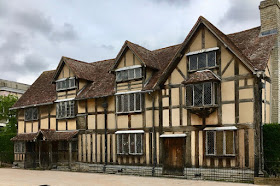No madding crowd
Yes, this is something you don’t often see on this blog: a really famous building. It’s Shakespeare’s birthplace, the house in Stratford that in normal times attracts crowds inside and out. But as we were emerging out of lockdown last month, Stratford was still quiet and I took the opportunity to take a photograph of the building without anyone standing in front of it. It’s not known for sure how long this house has stood here, but we do know that John Shakespeare, the poet’s father, was living here by 1552, when he was fined for leaving a midden heap (dumping trash, you might say) in the street outside. Not an auspicious entry into the historical record, but Shakespeare senior rose to prominence in Stratford-upon-Avon. A dealer in wool and hides and a maker of gloves, he was an alderman and spent a period as the town’s High Bailiff.
William Shakespeare inherited the house in 1601, by which time he was a successful playwright in London with his own house in his home town. So he leased the house to tenants. By the early-19th century, there were no surviving direct descendants of the dramatist, and the house fell into disrepair and was partly refaced in brick. When it came on the market in 1849, P. T. Barnum announced that he wanted to buy it, take it apart, and rebuild it in America. This was the spur that the British admirers of Shakespeare needed to buy the house themselves and preserve it. They raised the money, and repaired and refaced the building so that it looked much more like its 16th-century self.
At the same time, the second half of the 19th century saw a revaluation of Shakespeare as a writer. New editions of his works came out, a Shakespeare festival was started in Stratford, and a theatre was built to put on the plays. Shakespeare turned into a kind of national symbol (or at least into a symbol of England’s outstanding achievements in the arts), and Stratford attracted visitors from all over the world. Insofar as the street was quiet the other day, I welcomed the fact that the crowds of Shakespearian pilgrims were not visiting Stratford. But the bustle of the town in normal times, with its mixture of shoppers, theatre-goers, students, culture tourists, and even the odd literary scholar, cannot be too far from the diverse crowd that attended the plays in London’s Globe theatre in Shakespeare’s lifetime. Let’s hope they can return soon.

It's difficult to believe that Shakespeare was out of favour in the early 19th century. Jane Austen's characters enthuse about him, as do Goethe and continental writers. The Romantic Movement regarded him as an idol and a model. Tudor half-timber was probably more out of favour, particularly with those in Warwickshire towns and villages where the wood was beginning to look tatty and there was still a taste for Georgian brick. When they demolished a lovely black-and-white building in Dovehouse Lane, Solihull, in the 1960's I expect it had become extremely necessary on health and safety grounds. I was told Stratfordians don't always appreciate living in a museum.
ReplyDeleteJoseph: You're right. I was recalling how people – especially actors – thought so little of Shakespeare's text that they rewrote chunks of the plays, presenting King Lear, for example, with a happy ending. But this sort of thing was much more prevalent in the 18th century. The Romantics - from Goethe to Coleridge – were great enthusiasts, and both 18th and 19th century scholars produced good editions of the plays. I do think, though, that Shakespeare's reputation rose still higher in the mid- to late-19th century, as he became a kind of national symbol. And this was the period when the buildings in Stratford associated with him began to be valued more highly. So I'll edit my post and remove the bit about his reputation.
ReplyDeleteIt's many years since I visited that house but I still recall feeling a tingle of excitement on being there.
ReplyDeleteFrom YouGov: "Out of the 4081 strong – and growing – sample of writers YouGov currently collects data on, William Shakespeare is the third most popular, slightly below contemporary classics JK Rowling and Terry Pratchett but above Tolkien, Orwell, Roald Dahl and Dickens".
I think that's amazing for someone writing over 400 years ago!
CLICK HERE for Bazza’s suspiciously spasmodic Blog ‘To Discover Ice’